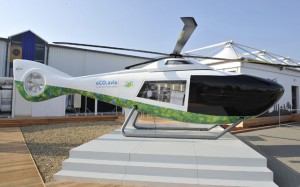
EADS unveiled a model of a hybrid helicopter concept at the ILA Berlin Airshow on June 8 which it says could cut emissions and fuel consumption in half while improving safety margins.
One of several projects that form part of EADS Innovation Works’s eCO2avia program, the helicopter concept would use four diesel-electric motor generator units, two high performance batteries and a power electronics unit. ‘Opposed piston opposed cylinder’ (OPOC) diesel engines would generate electrical power for the main and tail rotors, with their power output shafts coupled to generators delivering electrical current to a power electronics unit. This in turn would manage the distribution of electricity to the electric motors which would drive the main and tail rotors, to and from the batteries, and to other systems on the helicopter.
The architecture of the hybrid propulsion system would allow the main rotor and its electrical drive to be tilted forward during cruise flight, enabling the helicopter’s fuselage to remain at its optimum alignment with the airstream, minimising aerodynamic drag and reducing power demands and fuel consumption. The tail rotor would have no mechanical linkage to the main rotor and its power source could be reduced or turned off at higher speeds as stability, control and the balancing of rotor torque are provided by the aerodynamic properties of the helicopter’s tail fin and rudder.
Several combustion engine options would be able to be integrated into the patented hybrid helicopter concept which EADS hopes will make helicopters more environmentally friendly.
“The EADS Innovation Works Eco2Avia research platform will open up new possibilities for cleaner, safer and more quiet helicopter and aviation operations,” said Dr Jean Botti, EADS’s chief technical officer. “Takeoffs and landings will be possible on electrical power alone, resulting in lower noise levels and improved flight safety.”
EADS says the next step would be to build a flying prototype.














